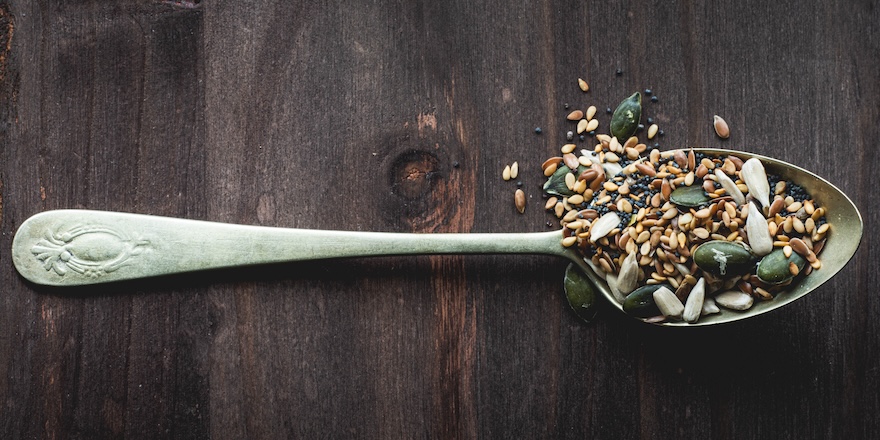Seed cycling is a dietary practice that involves consuming certain seeds during the different phases of the menstrual cycle, with the goal of supporting hormonal balance.
The first phase of the menstrual cycle (from the 1st day of menstruation until ovulation – about 14 days, but not always) is called the follicular phase because it’s during this phase that follicles mature. One, sometimes two, reach ovulation.
The seeds used during this phase should support the action of estrogens, hormones that allow follicular development. These are flaxseeds and pumpkin seeds, which have a mildly phytoestrogenic effect.
The second phase of the cycle, called the luteal phase, stretches from ovulation to menstruation, and its role is to provide a hormonal environment favorable to the possible implantation of an embryo, including a sufficient level of progesterone.
Sesame seeds and sunflower seeds, for the vitamins and minerals they contain, help eliminate excess estrogens and support progesterone. They are therefore recommended for this second phase.
Specialized in women’s nutrition and health, I analyzed what the studies say to understand whether seed cycling is really effective.
📚 Read also | Which dietary supplement for PMS? A pharmacist’s guide
What science tells us
Understanding seed cycling
In general, seed cycling, particularly through the consumption of flax and sesame seeds, would appear according to this scientific literature review to be associated with:
- more regular menstrual cycles
- a reduction in the severity of PMS (premenstrual syndrome) symptoms
- better regulation of sex hormone levels
- and improved metabolic profiles
Observed effects on women’s hormonal disorders
Another study showed that seed cycling, using the four seeds mentioned above, produced significant results in women with PCOS. And, more generally, improves female hormonal disorders.
Pumpkin seeds: prevention and hormonal support
Pumpkin seeds contain nutrients that may help prevent certain diseases.
Notably in the reduction of certain hormone-dependent tumors, and in certain menopause-related conditions, according to this study.
Flaxseeds: an ally in PCOS and metabolic regulation
Flax seeds have been studied in the context of PCOS. Here are some findings I’ve noted.
This study shows a significant reduction in ovarian volume, in the number of follicles in polycystic ovaries, and an improvement in the frequency of menstrual cycles
This study indicates that flaxseed supplementation could improve metabolic, hormonal and anthropometric parameters (such as weight) in women with PCOS.
Promising results, but to be confirmed.
However, note that most of these studies were conducted on small samples, and the authors point out that further studies need to be carried out to reach a solid conclusion.
In my practice, I have found seed cycling to be promising. But it is not sufficient on its own to support the cycle if hormonal imbalances are present.
In that case, a foundational approach focusing on lifestyle and nutrition, with the help of herbal medicine and targeted supplements, is necessary. And I think seed cycling can certainly be part of this approach.

My tips for getting started with seed cycling
During the first phase of the cycle
From the start of your period until ovulation (or during the first two weeks of the cycle if you don’t know when you ovulate), you can consume flax seeds and pumpkin seeds.
To have an effect, it’s recommended to consume one to two tablespoons of each type of seed per day. They can be easily added to a salad, yogurt, or even a soup or smoothie.
Flax seeds should be freshly ground, and you should thoroughly chew pumpkin seeds if you don’t want to grind them.
During the second phase of the cycle
From ovulation until your period (or from day 15 of the cycle if you don’t know when you ovulate), you can prioritize sesame seeds and sunflower seeds.
They can still be consumed at a rate of one to two tablespoons of each type of seed per day. They can be incorporated in the same way into a salad, yogurt, soup, or smoothie.
🎧 Listen to the podcast | Cherished Cycles: Women’s Well-being & Nutrition
Sources and scientific studies
Nagarajan DR, Mani Jacob D, Munir Mufti M, Rajesh S, Dube R. 2025. Efficacy of Seed Cycling as an Integrative Therapy for Premenstrual Syndrome and Polycystic Ovary Syndrome in Reproductive-Aged Women: A Systematic Review
Rasheed N, Ahmed A, Nosheen F, Imran A, Islam F, Noreen R, Chauhan A, Shah MA, Amer Ali Y. 2023. Effectiveness of combined seeds (pumpkin, sunflower, sesame, flaxseed): As adjacent therapy to treat polycystic ovary syndrome in females
Lestari B, Meiyanto E. 2018. A Review: The Emerging Nutraceutical Potential of Pumpkin Seeds
Fatima Farzana K, Abubacker Sulaiman F, Ruckmani A, Vijayalakshmi K, Karunya Lakshmi G, Shri Ranjini S, Duraivel M. 2015. Effects of Flax Seeds Supplementation in PolyCystic Ovarian Syndrome
Hadi Emamat, Saeid Najafpour Boushehri, Mohammad Ali Eslami, Ali Saneei Totmaj, Hamid Ghalandari. 2022. The effects of flaxseed or its oil supplementations on polycystic ovary syndrome: A systematic review of clinical trials



